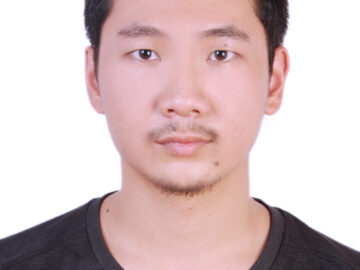Yansong Chen
MS Student
Institute of Cyber-Systems and Control, Zhejiang University, China
Biography
I am pursuing my M.S. degree in College of Control Science and Engineering, Zhejiang University, Hangzhou, China. My major research interests include Reinforcement Learning and UAV formation.
Research and Interests
- Reinforcement Learning
- UAV formation
- Computer Vision
Publications
- Yansong Chen, Yuchen Wu, Helei Yang, Junjie Cao, Qinqin Wang, and Yong Liu. A Distributed Pipeline for Collaborative Pursuit in the Target Guarding Problem. IEEE Robotics and Automation Letters (RA-L), 9:2064-2071, 2024.
[BibTeX] [Abstract] [DOI] [PDF]The target guarding problem (TGP) is a classical combat game where pursuers aim to capture evaders to protect a territory from intrusion. This paper proposes a distributed pipeline for multi-pursuer multi-evader TGP with the capability to accommodate varying numbers of evaders and criteria for successful pursuit. The pipeline integrates a cooperative encirclement-oriented distributed model predictive control (CEO-DMPC) method with a collaborative grouping strategy for trajectory planning of pursuers. This integration achieves cooperation and collision avoidance during the capture process across various scenarios. Besides, the objective function of CEO-DMPC employs sequences of predicted states instead of only a terminal state. Evaders are guided by the artificial potential field (APF) policy to reach their goals without being captured. Simulations with different parameters are conducted to validate the whole pipeline and the experiment results are illustrated and analyzed.
@article{chen2024adp, title = {A Distributed Pipeline for Collaborative Pursuit in the Target Guarding Problem}, author = {Yansong Chen and Yuchen Wu and Helei Yang and Junjie Cao and Qinqin Wang and Yong Liu}, year = 2024, journal = {IEEE Robotics and Automation Letters (RA-L)}, volume = 9, pages = {2064-2071}, doi = {10.1109/LRA.2024.3349977}, abstract = {The target guarding problem (TGP) is a classical combat game where pursuers aim to capture evaders to protect a territory from intrusion. This paper proposes a distributed pipeline for multi-pursuer multi-evader TGP with the capability to accommodate varying numbers of evaders and criteria for successful pursuit. The pipeline integrates a cooperative encirclement-oriented distributed model predictive control (CEO-DMPC) method with a collaborative grouping strategy for trajectory planning of pursuers. This integration achieves cooperation and collision avoidance during the capture process across various scenarios. Besides, the objective function of CEO-DMPC employs sequences of predicted states instead of only a terminal state. Evaders are guided by the artificial potential field (APF) policy to reach their goals without being captured. Simulations with different parameters are conducted to validate the whole pipeline and the experiment results are illustrated and analyzed.} } - Gang Xu, Yansong Chen, Junjie Cao, Deye Zhu, Weiwei Liu, and Yong Liu. Multivehicle Motion Planning with Posture Constraints in Real World. IEEE-ASME Transactions on Mechatronics, 27(4):2125-2133, 2022.
[BibTeX] [Abstract] [DOI] [PDF]This article addresses the posture constraints problem in multivehicle motion planning for specific applications such as ground exploration tasks. Unlike most of the related work in motion planning, this article investigates more practical applications in the real world for nonholonomic unmanned ground vehicles (UGVs). In this case, a strategy of diversion is designed to optimize the smoothness of motion. Considering the problem of the posture constraints, a postured collision avoidance algorithm is proposed for the motion planning of the multiple nonholonomic UGVs. Two simulation experiments were conducted to verify the effectiveness and analyze the quantitative performance of the proposed method. Then, the practicability of the proposed algorithm was verified with an experiment in a natural environment.
@article{xu2022mmp, title = {Multivehicle Motion Planning with Posture Constraints in Real World}, author = {Gang Xu and Yansong Chen and Junjie Cao and Deye Zhu and Weiwei Liu and Yong Liu}, year = 2022, journal = {IEEE-ASME Transactions on Mechatronics}, volume = {27}, number = {4}, pages = {2125-2133}, doi = {10.1109/TMECH.2022.3173130}, abstract = {This article addresses the posture constraints problem in multivehicle motion planning for specific applications such as ground exploration tasks. Unlike most of the related work in motion planning, this article investigates more practical applications in the real world for nonholonomic unmanned ground vehicles (UGVs). In this case, a strategy of diversion is designed to optimize the smoothness of motion. Considering the problem of the posture constraints, a postured collision avoidance algorithm is proposed for the motion planning of the multiple nonholonomic UGVs. Two simulation experiments were conducted to verify the effectiveness and analyze the quantitative performance of the proposed method. Then, the practicability of the proposed algorithm was verified with an experiment in a natural environment.} }

